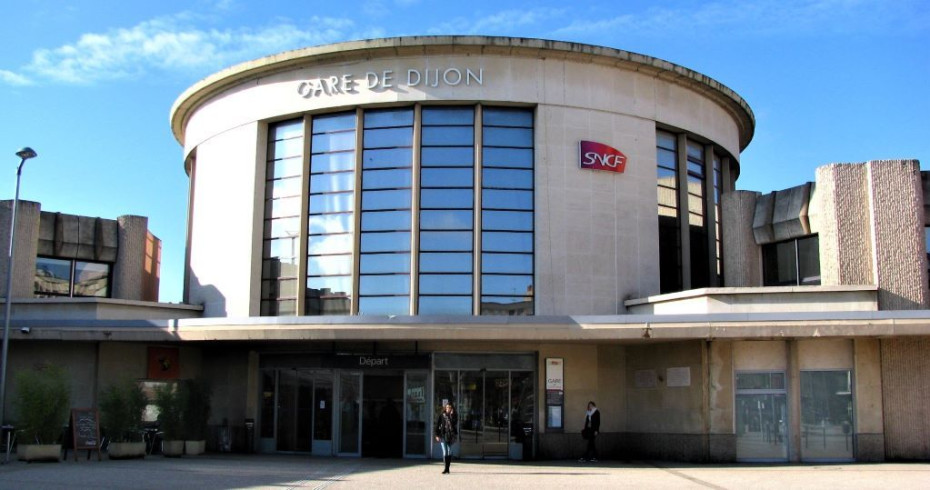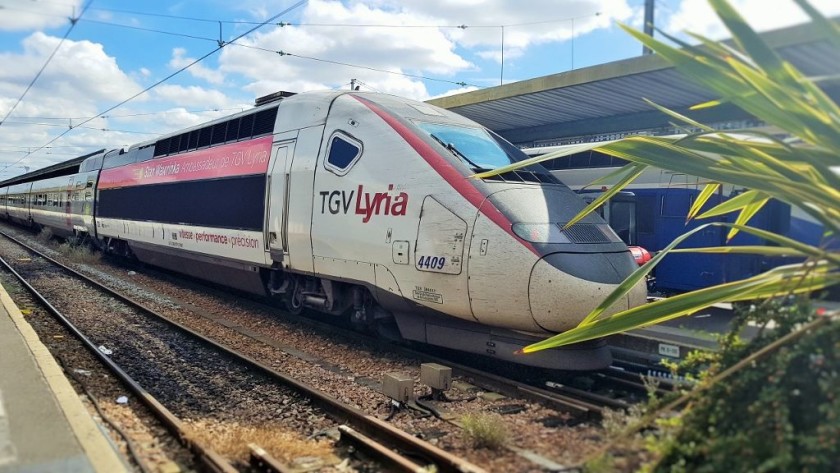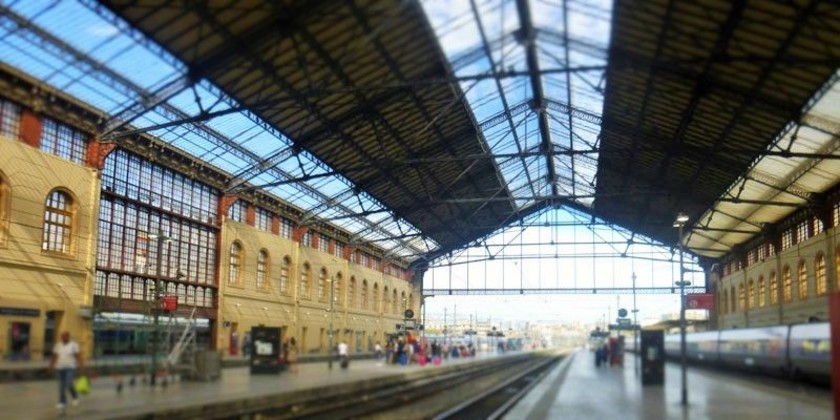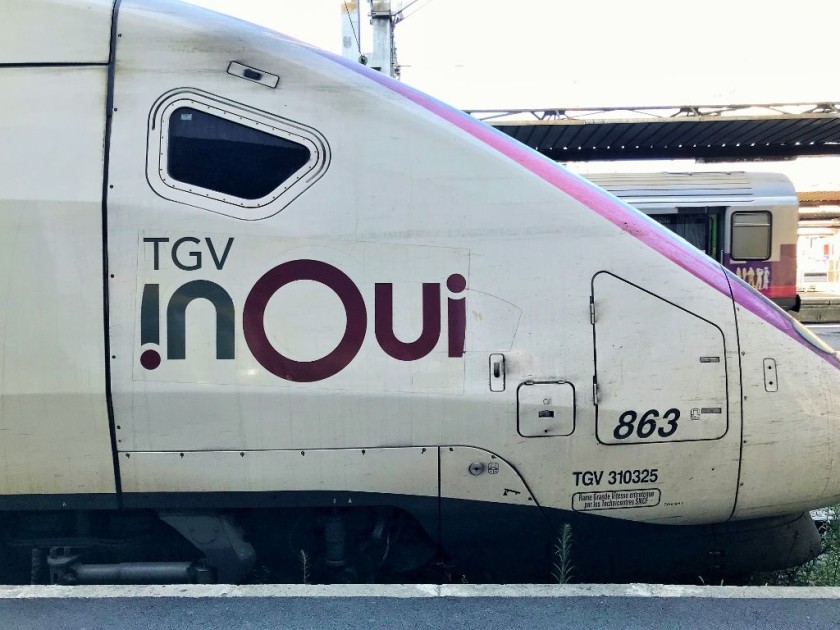Related Content
Content

Dijon-Ville (Dijon)
This guide to using Dijon-Ville station provides insights into what to look out for when departing and arriving in Dijon by train.
Share
At a Glance
Services
Left Luggage
Travel Information Desk
First Class Lounge
Local Tourism Information
Onward Travel
Bus Station
Car Hire
Taxi Rank
The station buildings at Dijon-Ville which gives access to the trains are in TWO distinct parts:
(1) Dijon’s Ville's most iconic feature is its rotunda main entrance, which has echoes of London Underground stations, as pictured on its Wikipedia page.
It houses the ‘SNCF Boutique’ ticket office the, the local transport info office (you can pick up maps of Dijon from here) and the access to the car hire offices
It is also where one of the access points to the voies B - J (platforms/tracks), where most of the trains depart from, is located.
(At Dijon-Ville most of the voies (platforms/tracks) have letters in place of numbers).
(2) If you enter the station through its main entrance, the access to the second part of the station, its main departure hall, is directly ahead, on the other side of the stairs/escalators.
This departure hall is the location of:
- the waiting room
- the Information desk
- the café
- the left luggage office; at the opposite end of the departure hall to the main entrance.
- the somewhat hidden elevator/ascenseur which provides alternative access to SOME of the trains; it’s located to one side of the entrance to the waiting room.
Departing By Train:
There are THREE primary means of accessing the trains at Dijon-Ville station.
(1) As you approach the main entrance to the station, you will see a steps and an escalator leading down to a below ground passage way.
If you already have a valid ticket and your train is departing from voies (platforms/tracks) B - J within 15 mins, then this entrance is a short-cut to trains leaving from this part of the station.
At Dijon-Ville the details of which specific voie (platform/track) each train will be departing from are only confirmed around 15 -20mins before they are due to leave.
So if you don’t know which voie (platform/track) your train will be leaving from, the better option is to head to the main departure hall in the station and wait for your train there.
(2) The main departure hall at the station is on the left side of the station forecourt and it houses most of the station’s facilities including a waiting room and cafés etc
So if you’ll have to wait for details of your train departure to be confirmed and don’t need to use the ticket office, your best option is to enter Dijon-Ville directly into this departure hall.
(3) The main entrance to the station is easy to spot, as it’s located at the station’s most distinctive feature, its round entrance hall.
However, you only need to use this entrance to the station if you need to use the ticket office, as it’s located within this entrance hall.
Accessing the trains:
Voies (platforms/tracks) A, 3, and 37 are on the same level as the main departure hall, so access to trains which depart from these voies (platform/tracks) is step-free.
Access to voies (platforms/tracks) C - J is by a passage way which runs beneath the railway lines.
The three main access points to this passage way are:
(1) on the forecourt outside the station by the bus stops - the quickest route to the trains if you already have a ticket.
(2) in the main departure hall - and
(3) the entrance hall.
Each has an escalator, in addition to the stairs, but the escalator is usually switched so that it is leading upwards.
Over by the entrance to the waiting room is an elevator, which leads down to this passage way.
However, once you're in this passage way, stairs provide the only means of accessing voies (platforms/tracks) C - H.
Only voies (platforms/tracks) I and J also have elevator access in addition to the stairs.
Arriving By Train at Dijon-Ville
If your train arrives at voies (platforms/tracks) A, 3, or 37 you’re in luck, these voies are adjacent to the street level station buildings so there’s step free access from these trains to the stations exits.
However, if your train arrives at voies (platforms/tracks) C-J you will have to use the passage way which runs beneath the railway lines to exit the station.
Stairs and an elevator link voies (platforms/tracks) I and J to this passage way, but stairs provide the only access on voies (platforms/tracks) C-H.
The town centre end of this passage way opens out into a lobby area, on the left of which is an elevator, which will take you up into the station buildings, which are at street level.
On the right of this lobby area is another passage way, which is the quickest exit from the station, as it leads to the forecourt where the bus and trams stops and the pedestrian route to the town centre are located.
This below ground lobby area also has two other exits which lead up into the station building - and if you are changing trains, they give access to the station facilities such as the cafés, waiting room etc.
Or if you want to stop by the public transport info and tourist office, you'll find it on the level above in the main entrance hall.
All of these three main exits from the passage way have an escalator, as well as the stairs, and the escalators are usually configured so that they lead upwards.
To the city centre from Dijon-Ville
Dijon-Ville station is conveniently located on the western edge of the city centre, so the heart of the city is approximately a 15 min walk from the station.
As the city centre is pedestrianised the buses and trams which depart from the station forecourt don’t penetrate the heart of the city, so setting off on foot can be the best or only viable option.
Once you’re on the station forecourt the tram tracks lead directly ahead on to Avenue Maréchal Foch and this street is is pedestrianised.
Within 5 – 10 mins walk you will be at the Place Darcy, which is at the western end of the Dijon’s main street, Rue de la Liberté.
The trams stop at Darcy, but it is only a 5 – 10 min walk from Dijon-Ville.
At the eastern, far, end of the Rue de la Liberté is the Place de la Libération, which is where the Musée des Beaux-Arts de Dijon is located.
Taking the free shuttle bus:
This area at the eastern end of the Rue de la Liberté is served by the free ‘City’ shuttle bus, which runs every 10 mins during the day on Monday – Saturday.
However, it’s stop at the ‘Gare’ is not on the forecourt of Dijon-Ville station, instead it is a 3 – 5 min walk from the station on the Boulevard de Sévignés.
To access it from Dijon-Ville don’t use the main exit from the station, instead exit on to ‘Avenue Albert 1er’.
When you step out of the station turn to the left and within 3 min you will come to a bridge which takes the train tracks over the road.
Go to the left, walk under the bridge and then on the other side, over to the left you will find the ‘City’ bus stop on Boulevard de Sévignés.
Journeys
# Jump to a directionDirections
Journeys to Dijon-Ville
Jump to directionsBasel / Bâle to Dijon by train
Lyon to Dijon by train
Marseille to Dijon by train
Paris to Dijon by train
This second version of ShowMeTheJourney is exciting and new, so we are genuinely thrilled that you are here and reading this, but we also need your help.
We’re striving not to let anything get in the way of providing the most useful service possible, hence a facility has been set up with DonorBox which can be used to support the running costs and make improvements.
Instead of advertising or paywalls, your financial support will make a positive difference to delivering an enhanced service, as there’s a lot of ideas which we want to make happen.
So if you have found the info provided here to be useful, please consider saying thank you.

This is one of more than 100 train travel guides available on ShowMeTheJourney, which will make it easier to take the train journeys you want or need to make. As always, all images were captured on trips taken by ShowMeTheJourney.






